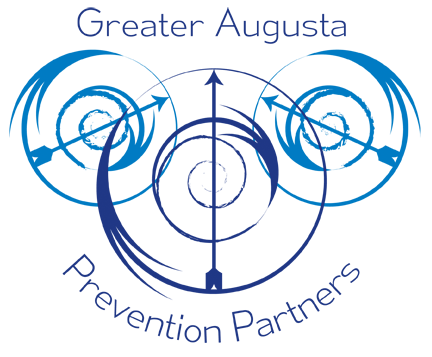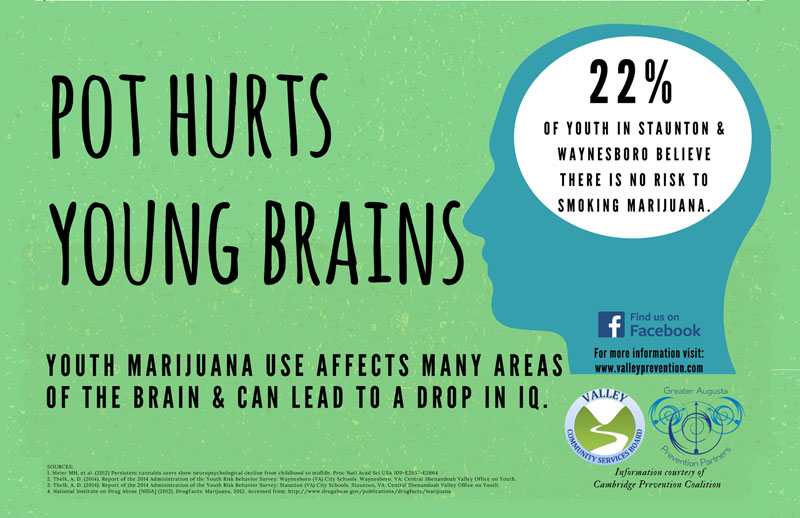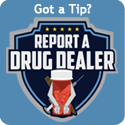Marijuana Hurts
Launched in 2018, the Marijuana Hurts campaign is designed to raise awareness about the effects of smoking marijuana among teens and the increased strength of today’s marijuana content. It is a joint campaign between Valley Community Services Board and Greater Augusta Prevention Partners, or GAPP Coalition.
Did You Know?
- More than 40 percent of teens try marijuana before they graduate from high school.
- Many teens do not consider marijuana to be a harmful drug.
- “The human brain does not fully mature until the early twenties. Among the last areas to develop are those that govern impulse control and planning. So what might that mean for teens? On one hand, they may be ore adventurous than adults, willing to take chances … on the other, this could involve risky behaviors, including drug use.”
(Source: National Institute of Drug Abuse)
- Research shows that marijuana use can have permanent effects on the developing brain when use begins in adolescence, especially with regular or heavy use.
- Frequent or long-term marijuana use is linked to school dropout and lower educational achievement
- The amount of tetrahydrocannabinol (THC) in marijuana (i.e., marijuana potency) has increased over the past few decades. The higher the THC content, the stronger the effects on the brain. In addition, newly popular methods of using marijuana (e.g., dabbing, edibles) may deliver very high levels of THC to the user.
- Eating foods or drinking beverages that contain marijuana have some different risks than smoking marijuana, including a greater risk of poisoning.
- Long-term or frequent marijuana use has been linked to increased risk of psychosis or schizophrenia in some users.
(Source: Center for Disease Control and Prevention, or CDC)
About Marijuana
- Marijuana can be addictive
- Marijuana is the second drug most often linked to car accidents, including those involving deaths
- Marijuana is linked to school failure
- Marijuana in high doses can cause psychosis or panic when used
THC, the main chemical in marijuana, content has been increasing over the past few decades according to the NIH, meaning today’s marijuana is stronger than it was 30 years ago.
Strong forms of cannabis or marijuana may include sinesemilla, hashish and hash oil.
Alternatives to marijuana such as K2/Spice are advertised to be a safe and legal alternative to the drug. According to the NIH, neither is true. The chemicals used in these drugs remain highly unknown and may have much different affects that the user expects.
(Source: National Institutes of Health)
Tips for Parents
Talking openly to teens about marijuana is a good start.
- Be a good listener
- Give clear no-user messages about drugs and alcohol
- Help your child deal with peer pressure to use drugs
- Get to know your child’s friends and parents
- Monitor your child’s whereabouts
- Supervise teen activities
- Talk to your child often
(Source: U.S. Department of Health and Human Services)
Additional Resources
- What You Need to Know About Marijuana Use in Teens
- Facts Parents Need to Know
- Facts for Teens
- Marijuana Talk Kit
- National Institute on Drug Abuse
Need Treatment?
Locally, please call Valley Community Services Board at 540-887-3200 or visit their website at www.myvalleycsb.org.
Outside the area? Call the Substance Abuse and Mental Health Services Administration, or SAMHSA, at 1-800-662-HELP or click here.
Find our Ads
- Zeus Digital Theaters
- Visulite Theater
- Comcast/Xfinity
- Harrisonburg Radio Group
- Augusta Free Press
- Lamar Billboard
- News Leader
- News Virginian
- Pizza Box Advertising
- Rack Cards
- Posters
Radio Spots







